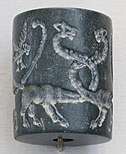Music of Mesopotamia
This article details the music of ancient Mesopotamia.
| Music of Mesopotamia | |
|---|---|
Background
Cuneiform sources reveal an orderly organized system of diatonic scales, depending on the tuning of stringed instruments in alternating fifths and fourths. Instruments of ancient Mesopotamia include harps, lyres, lutes, reed pipes, and drums. Many of these were shared with neighbouring cultures. Contemporary East African lyres and West African lutes preserve many features of Mesopotamian instruments (van der Merwe 1989, p. 10).
The vocal tone or timbre was probably similar to the pungently nasal sound of the narrow-bore reed pipes, and most likely shared the contemporary "typically" Asian vocal quality and techniques, including little dynamic changes and more graces, shakes, mordents, glides and microtonal inflections. Singers probably expressed intense and withdrawn emotion, as if listening to themselves, as shown by the practice of cupping a hand to the ear (as is still current in modern Assyrian music and many Arab and folk musics) (van der Merwe 1989, p. 11).
Two silver pipes have been discovered in Ur with finger holes, and a depiction of two reeds vibrating. This instrument would be close to the modern oboe. The ancient Mesopotamians do not seem to have had a clarinet-type of instrument (Duchesne-Guillemin 1981, ). A number of reconstructions have been proposed, the most recent being a pair of thin tubes with three finger holes in one tube and four finger holes in the other (Goss 2012).

For horned instruments, the Mesopotamians seem to have had horn instruments, similar to today's French horn and trumpet (Duchesne-Guillemin 1981, ). Only few surviving examples remain, for example a silver trumpet found in the tomb of the Pharaoh Tutankhamen. Most of the horns in ancient Mesopotamia were in fact horns from an animal, so would have decayed. These instruments would have worked like a bugle, using the harmonic series to get the notes needed for music. All tubes have a harmonic series; the image shown for the harmonic series shows what notes any tube can play. The blackened notes are out of tune, but are still recognizable as that particular pitch. The harmonic series makes a Lydian scale, shown from the 8th pitch in the picture to the 16th pitch, the 14th pitch not being a note on the Lydian scale.
Percussive instruments were only played in specific, ritualistic circumstances. Drums in ancient Mesopotamia were played not with sticks, but with the hands (Duchesne-Guillemin 1981, ). Plucked instruments, such as the harp, were more elaborate in many respects, being adorned decoratively with precious metals and stones. The harps found had anywhere from four to eleven strings. Plucked instruments came in many varieties, most differing in the manner in which they were intended to be held (Duchesne-Guillemin 1981, ).
Mesopotamian music theory
The ancient Mesopotamians seem to have utilized a cyclic theory of music, as seen through the numbering of their strings from the number one, through to the number five, then back down to one (Kilmer 1971, ). Through this, the pattern seems to arise that each string was used in separate parts of the music, the first string for the first part, the second string for the second part, and so on and so fourth. What makes the music cyclical is that the final string is tuned the same way as the first string, the second to last is the same as the second string, so the music will approach the fifth string then revert through the previous strings.
The Mesopotamians seem to have utilized a heptatonic Lydian scale, heptatonic meaning a scale with seven pitches. The Lydian scale is the regular major scale with a raised fourth. For example, the F-Lydian scale would contain the same key signature as a C-major scale. The F-Major scale has a B-flat in the key signature, however with the raised fourth in the Lydian scale, the B-flat becomes a B-natural. The drawback in modern music with the Lydian scale is the use of what is known today as the tritone, in this context an augmented fourth. The Mesopotamians did not seem to have a term for this tritone interval, nor a term for the octave, of which we know they had a concept (Kilmer and Tinney 1996, ). The use of a heptatonic scale would have eliminated any practical need for a term for the octave, as it would not have the importance that it has in today's music.
Mesopotamian music had a system that introduced rigidity in the music, preventing the melody from developing into chaos (Sachs 1943, ). Until recently no form of musical notation had been known, however there is a cuneiform tablet containing a hymn and what has been translated as musical instructions for a performer, making this tablet the oldest known musical notation. There were strict instructions for how to perform music, similar to chord progression today (Duchesne-Guillemin 1981, ). These instructions also seem to point to a strong desire for musicians to play in tune, with steps in performing requiring frequent attempts to tune the instruments (Kilmer and Tinney 1996, ).
Uses of music
Music for the ancient Mesopotamians had both a religious and a social aspect (Cheng 2009, ; Duchesne-Guillemin 1981, ). There was a different expectation for each musician, particularly vocalists. Whereas the religious singers were supposed to sing harshly, ignoring beauty to emphasize and focus on the religious chants, the social singers were expected to sing beautiful melodies.
See also
| Wikimedia Commons has media related to Music of Mesopotamia. |
Sources
- Cheng, Jack (2009). "A Review of Early Dynastic III Music: Man's Animal Call". Journal of Near Eastern Studies. 68 (3): 163–178. doi:10.1086/613988. JSTOR 10.1086/613988.CS1 maint: ref=harv (link)</ref>
- Duchesne-Guillemin, Marcelle (1981). "Music in Ancient Mesopotamia and Egypt". World Archaeology 12, no. 3:287–297. doi:10.1080/00438243.1981.9979803; JSTOR 124240.
- Goss, Clint (2012). "Flutes of Gilgamesh and Ancient Mesopotamia". Flutopedia. Retrieved 2012-01-08.CS1 maint: ref=harv (link)
- Irvine, Douglas (2003). "The Gold Lyre of Ur, c. 2650 BC (BCE)". WilliamSound.com (Accessed 19 January 2011).
- Kilmer, Anne Draffkorn (1971). "The Discovery of an Ancient Mesopotamian Theory of Music". Proceedings of the American Philosophical Society. 115: 131–49.CS1 maint: ref=harv (link)
- Kilmer, Anne, and Steve Tinney (1996). "Old Babylonian Music Instruction Texts." Journal of Cuneiform Studies 48:49–56. JSTOR 1359769; doi:10.2307/1359769.
- Roger, Peter, and Stuart Moorey (1976). Ancient Iraq: (Assyria and Babylonia). Oxford: Ashmolean Museum. ISBN 9780900090363
- Sachs, Curt (1943). The Rise of Music in the Ancient World, East and West. New York: W. W. Norton. ISBN 9780486466613.CS1 maint: ref=harv (link)
- van der Merwe, Peter (1989). Origins of the Popular Style: The Antecedents of Twentieth-Century Popular Music. Oxford: Clarendon Press. ISBN 0-19-316121-4.
Further reading
- Duchesne-Guillemin, Marcelle (1980). "Sur la restitution de la musique hourrite". Revue de Musicologie. 66 (1): 5–26. doi:10.2307/928544. JSTOR 928544.
- Duchesne-Guillemin, Marcelle (1984), "A Hurrian Musical Score from Ugarit: The Discovery of Mesopotamian Music", Sources from the Ancient Near East, Malibu, CA: Undena Publications, 2 (2), ISBN 0-89003-158-4
- Fink, Robert (1981). The Origin of Music: A Theory of the Universal Development of Music. Saskatoon: Greenwich-Meridian.
- Gütterbock, Hans (1970). "Musical Notation in Ugarit". Revue d'assyriologie et d'archéologie orientale. 64 (1): 45–52.
- Kilmer, Anne Draffkorn (1974). "The Cult Song with Music from Ancient Ugarit: Another Interpretation". Revue d'Assyriologie. 68: 69–82.
- Kilmer, Anne Draffkorn (1997). "Musik, A: philologisch". Reallexikon der Assyriologie und vorderasiatischen Archäologie 8, edited by Dietz Otto Edzard, 463–82. Berlin: De Gruyter. ISBN 3-11-014809-9.
- Kilmer, Anne (2001). "Mesopotamia §8(ii)". The New Grove Dictionary of Music and Musicians, second edition, edited by Stanley Sadie and John Tyrrell. London: Macmillan Publishers.
- Kilmer, Anne Draffkorn, Richard L. Crocker, and Robert R. Brown (1976). Sounds from Silence: Recent Discoveries in Ancient Near Eastern Music. Berkeley: Bit Enki Publications, 1976. Includes LP record, Bit Enki Records BTNK 101, reissued [s.d.] as CD.
- Vitale, Raoul (1982). "La Musique suméro-accadienne: gamme et notation musicale". Ugarit-Forschungen 14 (1982): 241–63.
- Wellesz, Egon, ed. (1957). New Oxford History of Music Volume I: Ancient and Oriental Music. Oxford: Oxford University Press.
- West, M[artin]. L[itchfiel]. (1994). "The Babylonian Musical Notation and the Hurrian Melodic Texts". Music and Letters 75, no. 2 (May): 161–79.
- Wulstan, David (1968). "The Tuning of the Babylonian Harp". Iraq 30:215–28.
- Wulstan, David (1971). "The Earliest Musical Notation". Music and Letters 52 (1971): 365–82.



